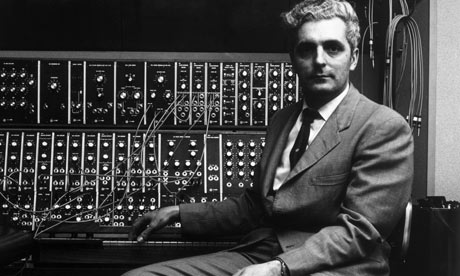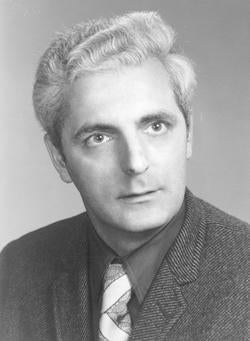Robert Moog
Robert " Bob" Moog (English: [ ɹɑ ː bɚt moʊg ]; * May 23, 1934 in New York City; † August 21, 2005 in Asheville, North Carolina) was a pioneer of electronic music and the inventor of the Moog synthesizer, a the first widely used electronic musical instruments.
Life
Moog studied physics at Queens College in New York City, which he left with a bachelor's degree. In the 1960s he built for the composer Max Brand Synthesizer Moogtonium the first. In 1963 he received his doctorate at Cornell University ( Ithaca, New York) in electrical engineering.
After he resigned from his company Moog Music Inc. in 1977, Moog was from 1989 to 1992 lessons in music technology at the University of North Carolina at Asheville. Robert Moog in 1984 presided over the jury " Grand Prix Ars Electronica " (Linz / Austria for pioneering new developments in the field of electronic sound production).
In April 2005 she was diagnosed with a glioblastoma Robert Moog. At this incurable brain tumor, he died four months later at the age of 71 years. His work is continued by the Bob Moog Foundation, founded by his son after his death.
The Theremin
Prior to the development of the synthesizer was another electronic musical instrument, the theremin, always in great demand even today with its unusual, hands-free operation. In addition to its inventor Lev Sergeyevich terms ( the Moog in 1989 met in Paris) was also Moog for the development of meaning.
As early as 1949 he discovered it for himself and built his own theremin. After he wrote an article about it for the journal Electronics World and also kits offered, which were very successful, he started in 1954 along with his father under the name RA Moog Co. in the basement of his home in Flushing, New York with the construction of theremins. In the 1960s he published a kit for a replica of a transistor theremin with great success. His personal highlight was when he created the Theremin by Clara Rockmore - could repair in the late 1980s - one of the best artists on the instrument. Today Moog Music Inc. is the leading provider of high-quality theremins.
Moog Theremins were used for many years for the background music of science fiction films and television series, Mars Attacks! and Babylon 5 are just two examples.
The synthesizer
The first developments of components for the later Moog synthesizer made at the Columbia - Princeton Electronic Music Center, now the Computer Music Center. These were, for example, the voltage-controlled oscillator (VCO ) and the ADSR envelope.
The first synthesizer in the 1950s and early 1960s were either bad to use - for example, with hole cards with the Mark II Music, who stood at the Columbia - Princeton Electronic Music Center - or of enormous size. The decisive factor was sure also that Moog was a student of Peter Mauzey, one of the developers of the Mark II Music. Moog introduced his first synthesizer in 1964 before at a convention of the Audio Engineering Society. He was due to its compact size at first only a curiosity, because the configuration still took hours, but this was corrected to 1968. During this time, Moog built with Fred Cochran for the home studio of the composer Max Brand synthesizer Moogtonium. The oldest still functioning synthesizer is now situated in the Max Brand Archive. In these years, Moog also employed the musician Walter Carlos, who in 1968 with the album Switched-On Bach won three Grammys, sparking a musical revolution.
The Moog synthesizer was not the only reason why the most widely used, Moog provided the only manufacturer to a keyboard as an input device, here he defined the standards. While the first Moogs were modular, so you could replace certain parts of the synthesizer against others, 1971, the Minimoog Model D on the market, which combined all functions in one compact housing. The instrument had 44 keys, three oscillators selectable with six waveforms, oscillator, mixer and controller for high altitudes and modulation. The third oscillator could also be used as LFO (Low Frequency Oscillator). The Minimoog became the most popular monophonic synthesizer of the 1970s, more than 13,000 were sold until 1982 and some special editions since 2001 have been put on the market as a Minimoog Voyager.
Under the Moog company launched in 1975 still widespread and very popular Taurus on the market. His pedals were similar to those of an organ, causing synthetic bass sounds. In 1977, Robert Moog 's Moog Music, which produced until 1986 keyboards.
The reasons for the separation of Moog Music Moog were lack of interest in economic matters, even minor failures could be dangerous for the company. The instrument maker Norlin bought Moog Music and Robert Moog devoted himself until his retirement from the company to the design of guitar effects, amplifiers and other small appliances.
Big Briar Productions
Moog moved in 1978 to North Carolina, where he founded Big Briar Productions, developed the effects modules and controls for electronic instruments and built. 1982 berühungsempfindliches keyboard was presented at the " International Computer Music Conference ." In addition to the pressure on the keys, the keyboard also recognized the horizontal position of the playing fingers and thus offered new possibilities. Unlike the first synthesizer developments of Big Briar had but not so big effect on the music, but they were creative and visionary.
In the early 1990s learned just Moogs first product, the theremin, a renaissance. Moog designed to this, the Series 91, and his company, Big Briar, she produced the next five years. In 1998 he designed a series of analog effects modules called Moogerfoogers. 2002 Moog got back the rights to the trademark Minimoog and Moog Music Minimoog Voyager and it was followed by, which heralded a new era with full MIDI support.
Services
The Beach Boys used for the hit Good Vibrations a "Electro - Theremin " or " Tannerin " by Paul Tanner, which is a special, thereminähnliches instrument based on other physical principles as the theremin. In live performances, Mike Love played an instrument that worked with a resistance band ( Moog Ribbon Controller ).
After introduction of the Minimoog 1970, Sound of the Moog spread in all imaginable genres from rock to rhythm and blues, from jazz to classical. One of the first rock musicians who used the Moog as a supporting instrument was Keith Emerson, pianist classical piano training at the publications Lucky Man, Tarkus, Trilogy, Brain Salad Surgery of the supergroup Emerson, Lake and Palmer.
The list of sounding with Moog Sound Hits is long - among others used Frank Zappa, Stevie Wonder, Jean Michel Jarre, Chick Corea and power plant, and occasionally even the Beatles, the Rolling Stones and Grateful Dead Moog synthesizer. World famous is Shine On You Crazy Diamond by Pink Floyd, the 1975 Minimoog began, to mimic the sound of a trumpet. The Taurus, however, was famous for his "fat" bass and was used by Genesis, Rush, U2, The Police and many others.
Moog set standards for the control of analog synthesizers. So he designed a logarithmic control for the pitch with 1V/octave and a separate pulse control signal. Also on the structure of the Minimoog synthesizer oriented themselves many manufacturers.
After analog synthesizers had been largely replaced by digital, they experienced a renaissance in the 2000s. Moog Music is currently making in addition to various effect units ago ( in different versions ) and the "Little Phatty " and theremins and a MIDI interface for pianos, the successor of the Minimoog, the Minimoog Voyager. The latest product is the " Moog Guitar", which was presented in 2008 at the NAMM.
Awards
For his life's work, he was in 1970 awarded the Grammy Trustees Award, for achievements in music, except musical work, is intended.
In 1991 he was awarded the SEAMUS Lifetime Achievement Award. 2001 Moog was awarded the unofficial " Nobel Prize for Music ", the Polar Music Prize, the 2002 Technical Grammy individual.
Quote
"Everything 's sounds, and can be changed with switches is a synthesizer. An instrument that you turn on and play, such as the Theremin, is not a synthesizer. But if you can do this and set the 'll put a patch cable here, another there, and thus the sound threading tail in its quality into new areas, then you have a synthesizer. And there were many devices before mine. "










